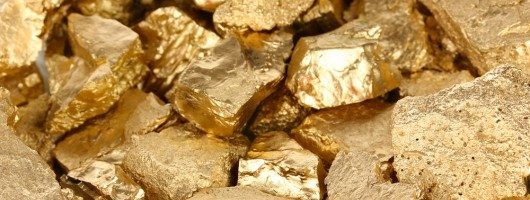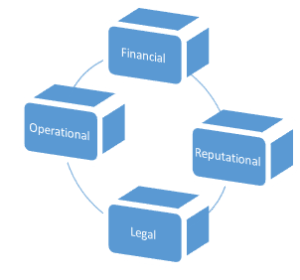Newmont Mining – Exploring Gold Mining and Climate Change

The precious metals industry contributes to Climate Change. Nonetheless, Climate Change is also shaping the precious metals industry. In this blog, I examine the consequences that this interrelationship entails through the lens of Newmont Mining, one of the leading precious metals mining companies. (746 words)
Gold Mining & Climate Change
In my five years in the precious metals industry, conversations around the environmental impact of gold mining on climate change have been limited. I find that very alarming, as it is estimated that 2% of Green House Gases Emissions result from the water and fossil fuel intensive nature of mining activity.[1] Does the precious metals industry take CSR seriously? Why is it that OECD guidelines on ‘good sourcing’ from non-conflict zones are more important than environmental issues[2]? Nevertheless, despite the scarcity of environmentally focused initiatives, steps taken by the Responsible Jewellery Council[3] and the International Council on Mining and Metals [4] have pushed mining companies to work towards mitigating and adapting to climate change.
Newmont Mining and its Sustainability Role
Newmont mining – the second largest player in the gold mining industry (Figure1) – has recognized challenges in regards to Climate Change[5]. Newmont has implemented climate change mitigation transparently by disclosing its carbon emissions since 2008 and by preparing a yearly sustainability report[6]. Moreover, Newmont became the first the gold mining company selected for the Dow Jones sustainability index[7].
Figure 1: Source – http://www.mining.com/the-worlds-top-10-gold-producers/
What may have prompted Newmont to tackle climate change? Since the early 2000s Newmont has been facing challenges with its environmental damage i.e. perceived water pollution in Indonesia damaged its reputation, concerns over water impact on a community in Peru led to a shutdown of operations and legal implications both in 2004[8] and 2011[9]. In light of recognition of climate change and environmental protection, a power shift has occurred to communities, media and legal authorities.
The Implications of Climate Change on Newmont
The manifestation of climate or related regulations could have ample effect on Newmont Mining’s business[10]. These effects could be categorized into organizational, legal, reputational and financial. It could be argued that financial could also be affected by organizational, legal and reputational impact as well, as the effect that climate change could have on Newmont may be amplified by the inter-relational aspects of these elements[11] (Figure2). For example, severe weather conditions such as increase in wildfires, drought and/or increase in water levels could disrupt operations, production schedules, routes, infrastructure and risk safety for employees[12] (Figure3). Any risk safety for employees could damage the firm’s reputation globally and within the community it is installed, lead to litigations and impact Newmont financially.
Figure 2: Categorization of the Impacts of Climate Change on Organizations Figure 3: Climate Change Cycle for Businesses
The Impact of Newmont on Climate Change
Having identified the implications that climate change could have on Newmont, it is essential to understand how Newmont’s mining business is impacting climate change. The main processes of mining – exploration, construction of the mine, extraction (mining and support operations) and closure of the mine – contribute largely to Green House Gases emissions through the burning of fossil fuels. Furthermore, due to the decreasing availability of higher-graded gold at surface and the need to dig deeper to find gold, it is estimated that emissions will continue to increase over time[13] [14]. A worrying example is that in 2015, despite having made an effort to lower utilization of coal energy, Newmont increased its emissions of CO2. Moreover, through water pollution, water consumption, wastage, mercury production, etc., mining affects the environment and ecosystem, which in turn amplifies the effect of climate change (Figure3).
Figure 4: Source – http://sustainabilityreport.newmont.com/2015/
Newmont’s Action to mitigate climate change
Newmont is working towards mitigating climate change (and its associated risks), and working towards a plan to adapt to the consequences of climate change. It has essentially recognized financial and environmental benefits to switching to low-carbon and more efficient sources of energy. It has also undertaken feasibility studies such as how to use solar energy to power its operations at the Tanami mine situated in an arid region in Australia. Thus saving 13% of the mine’s fuel consumption and using renewable clean source of energy[15]. Other steps taken are: recycling 59 % of its water[16], taking into consideration the impact of their operations on the ecosystem, managing the disposal of rocks and waste and minimizing mercury and cyanide[17].
How could Newmont further adapt and mitigate climate change
Despite the steps taken to tackle climate change, Newmont could be doing more. It has so far only taken a ‘precautionary approach’[18][19], and it may be argued that businesses should embrace radical changes in response to climate change[20]. But how? Newmont’s competitor – Barrick Gold may have taken more radical steps in fighting climate change, as it’s Carbon Disclosure A- rating is higher than Newmont’s B. However, as an ex-participant of the precious metals industry, the radical changes will only happen once the conversation around climate change becomes an important matter.
[1] https://www.icmm.com/publications/pdfs/5173.pdf
[2] http://www.washingtonpost.com/wp-dyn/content/article/2010/09/20/AR2010092004730.html
[3] http://www.responsiblejewellery.com/files/RJC_Code_of_Practices_2013_eng.pdf
[4] http://hub.icmm.com/document/9504
[5] http://sustainabilityreport.newmont.com/2013/_docs/Carbon%20Mgt%20Policy_BtM%20FINAL.pdf
[6] http://sustainabilityreport.newmont.com/2015/overview/about-this-report
[7] http://www.climatechangebusiness.com/Climate_Change_and_the_Mining_Industry
[8] http://web.unep.org/geo/sites/unep.org.geo/files/documents/geo5_for_business.pdf
[9] https://www.ft.com/content/528f72f8-4b3f-11e5-b558-8a9722977189
[10] https://www.bsr.org/reports/BSR_Climate_Adaptation_Issue_Brief_Mining.pdf
[11] http://web.unep.org/geo/sites/unep.org.geo/files/documents/geo5_for_business.pdf
[12] http://sustainabilityreport.newmont.com/2015/environmental-stewardship/energy-and-climate-change
[13] http://www.sciencedirect.com.ezp-prod1.hul.harvard.edu/science/article/pii/S0301420707000359
[14] http://barrickbeyondborders.com/mining/2014/05/something%E2%80%99s-gotta-give-gold-mining%E2%80%99s-energy-challenge/?utm_source=16RR&utm_medium=abx&utm_campaign=tile
[15] http://sustainabilityreport.newmont.com/2015/case/16/harnessing-the-sun-to-cut-diesel-consumption?cat=env
[16] http://sustainabilityreport.newmont.com/2015/environmental-stewardship/water
[17] http://www.newmont.com/sustainability/environment/default.aspx
[18] http://sustainabilityreport.newmont.com/2015/overview/gri—icmm—ungp-reporting
[19] http://sustainabilityreport.newmont.com/2015/overview/our-approach-to-sustainability
[20] http://ac.els-cdn.com/S0959652612000984/1-s2.0-S0959652612000984-main.pdf?_tid=6217e080-a2d1-11e6-bea6-00000aab0f02&acdnat=1478293266_c98155263a8bc69b39e6fb17ab41361b
Bibliography:
Reading:
Brett Walton, “Conga mine in Peru halted by water concerns, civic opposition”, Circle of Blue (April 21, 2016) http://www.circleofblue.org/2016/south-america/conga-mine-peru-halted-water-concerns-civic-opposition/
Charles Vorosmarty et al., “Global Water Resources: Vulnerability from Climate Change and Population Growth”, Science, 289, 284 (2000) http://water-pire.uci.edu/wp-content/uploads/2013/08/1_Hao_Science-2000-V%C3%B6r%C3%B6smarty-284-8.pdf
Delphi Group on behalf of Mining Association of Canada, “Climate Adaptation in the Canadian Mining Sector”, (July 7, 2014) http://mining.ca/sites/default/files/documents/Climate_Adaptation_in_the_Canadian_Mining_Sector_2014.pdf
Erik Klauk, “Environmental Impacts at Fort Belknap from Gold Mining”, DLESE Community Services Project – Carleton, http://serc.carleton.edu/research_education/nativelands/ftbelknap/environmental.html
Henderson, Reinert, Dekhtyar,and Amrammigdal, “Climate Change in 2016: Implications for Business”, Harvard Business School Case (October 14, 2016)
Oliver Balch, “Peruvian farmer wins David-and-Goliath battle against US mining giant”, The Guardian (April 21, 2016) https://www.theguardian.com/sustainable-business/2016/apr/21/peru-farmer-wins-battle-newmont-mining-corporation
Douglas Main, “How Climate Change Could Make Mercury Pollution Worse”, Live Science (September 26, 2013) http://www.livescience.com/39983-climate-change-worsens-mercury-pollution.html
Newmont, “Beyond the Mine: Our 2014 Social and Environmental Performance”, Newmont (2014) http://sustainabilityreport.newmont.com/2014/environmental/environmental-climate.php
Newmont, “Beyond the Mine: Our 2015 Social and Environmental Performance”, Newmont (2015) http://sustainabilityreport.newmont.com/2015/overview/our-business
Newmont, “Sustainability & Stakeholder Engagement Policy”, Newmont (April 28, 2014)
ICMM, “ICMM Statement on Climate Change”, ICMM, (October 21, 2015)
http://www.miningfacts.org/Environment/What-are-the-water-quality-concerns-at-mines-/
Orville D. Mussey, “Water Requirements of the Copper Industry”, Geological Survey Water (1961)
Newmont, “Newmont Carbon Management Policy”, Newmont (2013)
http://sustainabilityreport.newmont.com/2013/_docs/Carbon%20Mgt%20Policy_BtM%20FINAL.pdf
Julian Nelson and Ryan Schuchard, “Adapting to Climate Change: A guide to the mining industry”, BSR
Nina S. Rastogi, “Production of gold has many negative environmental effects, Washington Post (September 21, 2010) http://www.washingtonpost.com/wp-dyn/content/article/2010/09/20/AR2010092004730.html
Gavin M. Mudd, “Global trends in gold mining: towards quantifying environmental and resource sustainability”, Science Direct, (March-June 2007) – Vol.32, Issue 1. http://www.sciencedirect.com.ezp-prod1.hul.harvard.edu/science/article/pii/S0301420707000359
Catherina Pellegrino and Sumit Lodhia, “Climate change accounting and the Australian mining industry: exploring the links between corporate disclosure and the generation of legitimacy”, Journal of Cleaner Production (2012): 36, 68-82 http://ac.els-cdn.com/S0959652612000984/1-s2.0-S0959652612000984-main.pdf?_tid=6217e080-a2d1-11e6-bea6-00000aab0f02&acdnat=1478293266_c98155263a8bc69b39e6fb17ab41361b
Websites
http://www.hbs.edu/environment/resources/climate-change-101/Pages/default.aspx
http://www.hbs.edu/environment/resources/climate-change-101/Pages/effects-of-climate-change.aspx
https://www.reference.com/science/gold-mining-affect-environment-8066596619595c8e#
http://nodirtygold.earthworksaction.org/impacts#.WBzwTuErLeQ
https://en.wikipedia.org/wiki/Environmental_impact_of_mining
http://www.newmont.com/sustainability/environment/default.aspx
http://sustainabilityreport.newmont.com/2015/overview/gri—icmm—ungp-reporting
https://en.wikipedia.org/wiki/Acid_mine_drainage
https://en.wikipedia.org/wiki/Copper_extraction_techniques
http://www.oecd.org/corporate/mne/mining.htm
http://sustainabilityreport.newmont.com/2015/environmental-stewardship/water
http://www.newmont.com/sustainability/environment/default.aspx
http://sustainabilityreport.newmont.com/2015/overview/gri—icmm—ungp-reporting
https://www.bsr.org/reports/BSR_Climate_Adaptation_Issue_Brief_Mining.pdf
http://web.unep.org/geo/sites/unep.org.geo/files/documents/geo5_for_business.pdf
http://sustainabilityreport.newmont.com/2015/environmental-stewardship/energy-and-climate-change
http://www.sciencedirect.com.ezp-prod1.hul.harvard.edu/science/article/pii/S0301420707000359
https://www.icmm.com/publications/pdfs/5173.pdf
http://www.washingtonpost.com/wp-dyn/content/article/2010/09/20/AR2010092004730.html
http://www.responsiblejewellery.com/files/RJC_Code_of_Practices_2013_eng.pdf
http://hub.icmm.com/document/9504
[1] http://sustainabilityreport.newmont.com/2013/_docs/Carbon%20Mgt%20Policy_BtM%20FINAL.pdf
[1] http://sustainabilityreport.newmont.com/2015/overview/about-this-report
[1] http://www.climatechangebusiness.com/Climate_Change_and_the_Mining_Industry
[1] http://web.unep.org/geo/sites/unep.org.geo/files/documents/geo5_for_business.pdf
[1] https://www.ft.com/content/528f72f8-4b3f-11e5-b558-8a9722977189
http://www.responsiblejewellery.com/files/RJC_Code_of_Practices_2013_eng.pdf






Great post. Coming from the energy investing industry, I certainly agree that sustainability is extremely important for companies and shareholders in the mining industry. I’m impressed that the company has already achieved using 50+% recycled water. I would be curious as to whether the company has set any firmwide goals for percentage of energy derived from renewable sources (one of its competitors, Gold Fields, appears to be sourcing 20+% of its energy from renewable sources, versus Newmont’s 13%).
Secondly, while I realize that Newmont is a single-commodity producer, I would be curious as to how Newmont or other companies within the industry think about diversifying climate-related risks by investing across multiple commodities. Gold Fields, for example, is also exploring the feasibility of this option to become less reliant on gold and its associated climate change risks (https://www.bsr.org/reports/BSR_Climate_Adaptation_Issue_Brief_Mining.pdf).
Finally, one question that certainly comes to mind regarding energy companies that are attempting to adjust their operations to better align with climate change is how steadfast these companies remain with changes in commodity prices. We’ve certainly seen a broader commodity downturn over the past two years – hopefully these firms have kept to their sustainability initiatives, versus reverting to their previously less sustainable operations for shorter term profits in a difficult environment.
Thanks for sharing that. You are making great points.
Although Newmont is mainly focused in producing gold (84% of sales), it also produces Copper (16% of sales). I am afraid that the climate-related risks would not diversify away by investing across these 2 commodities, as operations are very similar. The best way to diversify would probably be geographically. I do not know about diversifying with non-metals commodities.
I also hope that mining companies will not sacrifice their sustainability initiatives. I believe that they have a lot to lose in terms of reputation. However, this is to be seen.
It is interesting how relevant the issue of climate change is across industries. News and media outlets so often talk about climate change in context to a few limited sectors and important discussions like this may never make it to the broader audience. This discussion truly shows how climate change is impacting sectors that many people (including myself) are overlooking. It is interesting however, how much progress has been made in this space by the industry leaders. I think that some of the achievements Newmont has made are quite impressive – especially in the light of other market competitors no considering climate impact in the decisions that they are making. This reinforces the idea that our society as a whole very much relies on the labors of industry leaders to start conversations, and provoke change for the greater good in places where government regulations or financial incentive structures may not be doing so already.